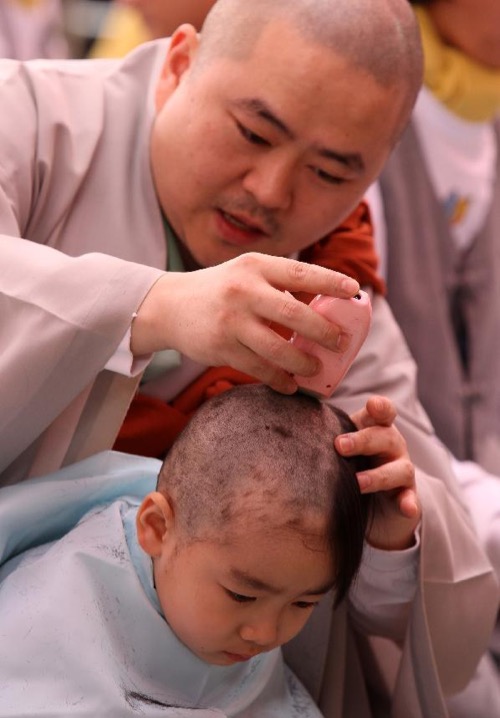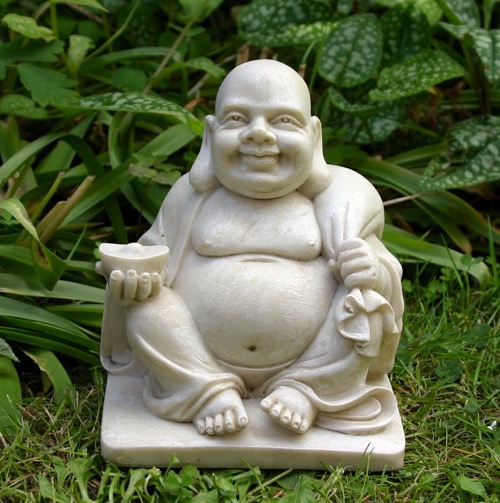4. Body in Buddhism
Photo of a tonsure in South Korea

A South Korean boy gets his head shaved by a Buddhist monk during a "Children Becoming Buddhist monks" ceremony at Jogye temple in Seoul on May 13, 2012. The children will stay at the temple to learn about Buddhism for 20 days ahead of celebrations for Buddha's birthday.
Photo of a tonsure in South Korea
Copyright AFP/Getty Image
Retrieved by http://www.dailymail.co.uk (03/09/2014)
Discourse on Noble Eightfold Path
Monks, these two extremes ought not to be practiced by one who has gone forth from the household life. (What are the two?) There is addiction to indulgence of sense-pleasures, which is low, coarse, the way of ordinary people, unworthy, and unprofitable; and there is addiction to self-mortification, which is painful, unworthy, and unprofitable. Avoiding both these extremes, the Buddha has realized the Middle Path; it gives vision, gives knowledge, and leads to calm, to insight, to enlightenment and to Nirvana. And what is that Middle Path realized by the Buddha? It is the Noble Eightfold path, and nothing else, namely: right understanding, right resolve, right speech, right action, right livelihood, right effort, right mindfulness and right concentration. Translated from the Pali by Piyadassi Thera, 1999
The “The Setting in Motion of the Wheel of Dharma” is a Buddhist text that is considered to be a record of the first teaching given by the Buddha after he attained enlightenment. Enlightenment is the comprehension of the cosmic order and the impermanence of all the things, obtaining a blissful state free from any kind of suffering called Nirvana. This kind of texts that are thought to present the words of the Buddha are called Sutras.
"Dhammacakkappavattana Sutta: Setting in Motion the Wheel of Truth" (SN 56.11),
Translated from the Pali by Piyadassi Thera. Access to Insight (Legacy Edition), 2013,
Retrieved by http://www.accesstoinsight.org/tipitaka/sn/sn56/sn56.011.piya.html .
Image of Pu-tai statue
The image of a fat and laughing Buddha is very widespread especially in China and Est Asia. It represents a Chinese Buddhist monk named Budai or Pu-tai remembered for his loving character, bounty, and kindness.

Image of Pu-tai statue (Creative Commons license, by Mark Belokopytov https://www.flickr.com/photos/markb120/2945707092/in/set-72157594365595594 ) CC BY-NC-ND 2.0
Letter. Thich Nhat Nanh.
Letter. Thich Nhat Nanh. "In Search of the Enemy of Man (addressed to (the Rev.) Martin Luther King)." In Nhat Nanh, Ho Huu Tuong, Tam Ich, Bui Giang, Pham Cong Thien. Dialogue. Saigon: La Boi, 1965. P. 11-20.
The self-burning of Vietnamese Buddhist monks in 1963 is somehow difficult for the Western Christian conscience to understand. The Press spoke then of suicide, but in the essence, it is not. It is not even a protest. What the monks said in the letters they left before burning themselves aimed only at alarming, at moving the hearts of the oppressors and at calling the attention of the world to the suffering endured then by the Vietnamese. To burn oneself by fire is to prove that what one is saying is of the utmost importance. There is nothing more painful than burning oneself. To say something while experiencing this kind of pain is to say it with the utmost of courage, frankness, determination and sincerity. During the ceremony of ordination, as practiced in the Mahayana tradition, the monk-candidate is required to burn one, or more, small spots on his body in taking the vow to observe the 250 rules of a bhikshu, to live the life of a monk, to attain enlightenment and to devote his life to the salvation of all beings. One can, of course, say these things while sitting in a comfortable armchair; but when the words are uttered while kneeling before the community of sangha and experiencing this kind of pain, they will express all the seriousness of one's heart and mind, and carry much greater weight.
The Vietnamese monk, by burning himself, say with all his strengh [sic] and determination that he can endure the greatest of sufferings to protect his people. But why does he have to burn himself to death? The difference between burning oneself and burning oneself to death is only a difference in degree, not in nature. A man who burns himself too much must die. The importance is not to take one's life, but to burn. What he really aims at is the expression of his will and determination, not death. In the Buddhist belief, life is not confined to a period of 60 or 80 or 100 years: life is eternal. Life is not confined to this body: life is universal. To express will by burning oneself, therefore, is not to commit an act of destruction but to perform an act of construction, i.e., to suffer and to die for the sake of one's people. This is not suicide. Suicide is an act of self-destruction, having as causes the following:
• lack of courage to live and to cope with difficulties
• defeat by life and loss of all hope
• desire for non-existence (abhava)
This self-destruction is considered by Buddhism as one of the most serious crimes. The monk who burns himself has lost neither courage nor hope; nor does he desire non-existence. On the contrary, he is very courageous and hopeful and aspires for something good in the future. He does not think that he is destroying himself; he believes in the good fruition of his act of self-sacrifice for the sake of others. […]
June 1, 1965
NHAT HANH
Thich Nhat Hanh is a Vietnamese Buddhist monk engaged for peace since Vietnam War. In this source, the monk explains Buddhist self-immolation practice to Martin Luther King, the famous American pastor, activist, humanitarian, and leader of African-American Civil Rights Movement using nonviolent civil disobedience. The Buddhist monk describes self-immolation as a form of protest in extreme cases avoiding violence against others. He also writes: "The bodhisattva shone his light about him so that everyone could see as he could see, giving them the opportunity to see the deathless nature of the ultimate."
Letter. Thich Nhat Nanh. "In Search of the Enemy of Man (addressed to (the Rev.) Martin Luther King)." in Nhat Nanh, Ho Huu Tuong, Tam Ich, Bui Giang, Pham Cong Thien. Dialogue. Saigon: La Boi, 1965. P. 11-20.






